Jewish Historical Fiction for Older Readers: The Holocaust (Page 3) |
If you wish to purchase any of these books, click on either the title or the book cover to be directed to Amazon.com. As a warning, I have put up pictures of the book covers to give you somewhat an idea of the style of each book (I know, I know. "Don't judge a book by its cover") so the pages may load slowly, depending on the speed of your internet connection.
If this page came up without frames, Click here to see the complete website
For biographies of individuals associated with the Holocaust (Anne Frank,
Simon Wiesenthal, etc.), go to the
Biographies
For Nonfiction Holocaust books, go to the
Holocaust History Page
For Holocaust books for younger readers, go to the Children's History Page
Other Pages of Interest:
Holocaust Historical Fiction Books For Middle School and Young Adult Readers ...
(Page 1)
(Page 2)
(Page 3)
(Page 4)
(Page 5)
(Page 6)
Holocaust History Books For Middle School and Young Adult Readers (Nonfiction)...
(Page 1)
(Page 2)
(Page 3)
(Page 4)
(Page 5)
(Page 6)
Middle School and YA Books ...
Bar Mitzvah Books |
Jewish Fiction |
Historical Fiction |
Torah Study |
Prayer and Jewish Life Books |
Jewish Holidays |
Jewish Biographies |
Jewish History Books |
Holocaust Books for Teens |
Israel Books
Jewish Historical Fiction for Middle School and YA Readers...
Biblical Era |
Middle Ages, Renaissance, and the Spanish Inquisition |
Immigration & The American Experience |
European History |
Holocaust
(Page 1)
(Page 2)
(Page 3)
(Page 4)
(Page 5)
(Page 6) |
Israel
Jewish History Books for Middle School and Young Adult Readers ...
General Jewish History & Nonfiction |
Biblical Era |
European History (Excluding the Holocaust) |
Immigration & The American Experience |
Holocaust |
Israel
Easy Reader and Picture Books ...
Jewish Children's Books (General) |
Jewish Board Books |
Biblical Stories for Children |
Jewish Holiday Books |
Jewish Family Cookbooks |
Folktales and Talmudic Stories for Children |
Jewish Life Books (Mitzvot, Keeping Kosher, etc.) |
Jewish Life Cycle Books |
Family Haggadahs |
Children's Prayerbooks |
Introductory Hebrew Books |
Jewish History and Historical Fiction Picture Books |
Israel Books
And More ...
Jewish Books for Children |
Bar Mitzvah Books |
Jewish Parenting Books |
Hanukkah Books |
Jewish Music for Children |
Jewish Videos |
Jewish Toys and Gifts |
Jewish Gift Baskets and Gourmet Food |
Jewish Jewelry |
Amazon.com Coupons, Promotions, and Sales
For biographies of individuals associated with the Holocaust (Anne Frank,
Simon Wiesenthal, etc.), go to the
Biographies
For Nonfiction Holocaust books, go to the
Holocaust History Page
For Holocaust books for younger readers, go to the Children's History Page
Other Pages of Interest:
Holocaust Historical Fiction Books For Middle School and Young Adult Readers ...
(Page 1)
(Page 2)
(Page 3)
(Page 4)
(Page 5)
(Page 6)
Holocaust History Books For Middle School and Young Adult Readers (Nonfiction)...
(Page 1)
(Page 2)
(Page 3)
(Page 4)
(Page 5)
(Page 6)
Middle School and YA Books ...
Bar Mitzvah Books |
Jewish Fiction |
Historical Fiction |
Torah Study |
Prayer and Jewish Life Books |
Jewish Holidays |
Jewish Biographies |
Jewish History Books |
Holocaust Books for Teens |
Israel Books
Jewish Historical Fiction for Middle School and YA Readers...
Biblical Era |
Middle Ages, Renaissance, and the Spanish Inquisition |
Immigration & The American Experience |
European History |
Holocaust
(Page 1)
(Page 2)
(Page 3)
(Page 4)
(Page 5)
(Page 6) |
Israel
Jewish History Books for Middle School and Young Adult Readers ...
General Jewish History & Nonfiction |
Biblical Era |
European History (Excluding the Holocaust) |
Immigration & The American Experience |
Holocaust |
Israel
Easy Reader and Picture Books ...
Jewish Children's Books (General) |
Jewish Board Books |
Biblical Stories for Children |
Jewish Holiday Books |
Jewish Family Cookbooks |
Folktales and Talmudic Stories for Children |
Jewish Life Books (Mitzvot, Keeping Kosher, etc.) |
Jewish Life Cycle Books |
Family Haggadahs |
Children's Prayerbooks |
Introductory Hebrew Books |
Jewish History and Historical Fiction Picture Books |
Israel Books
And More ...
Jewish Books for Children |
Bar Mitzvah Books |
Jewish Parenting Books |
Hanukkah Books |
Jewish Music for Children |
Jewish Videos |
Jewish Toys and Gifts |
Jewish Gift Baskets and Gourmet Food |
Jewish Jewelry |
Amazon.com Coupons, Promotions, and Sales
Other Pages of Interest:
Holocaust Historical Fiction Books For Middle School and Young Adult Readers ...
(Page 1)
(Page 2)
(Page 3)
(Page 4)
(Page 5)
(Page 6)
Holocaust History Books For Middle School and Young Adult Readers (Nonfiction)...
(Page 1)
(Page 2)
(Page 3)
(Page 4)
(Page 5)
(Page 6)
Middle School and YA Books ...
Bar Mitzvah Books |
Jewish Fiction |
Historical Fiction |
Torah Study |
Prayer and Jewish Life Books |
Jewish Holidays |
Jewish Biographies |
Jewish History Books |
Holocaust Books for Teens |
Israel Books
Jewish Historical Fiction for Middle School and YA Readers...
Biblical Era |
Middle Ages, Renaissance, and the Spanish Inquisition |
Immigration & The American Experience |
European History |
Holocaust
(Page 1)
(Page 2)
(Page 3)
(Page 4)
(Page 5)
(Page 6) |
Israel
Jewish History Books for Middle School and Young Adult Readers ...
General Jewish History & Nonfiction |
Biblical Era |
European History (Excluding the Holocaust) |
Immigration & The American Experience |
Holocaust |
Israel
Easy Reader and Picture Books ...
Jewish Children's Books (General) |
Jewish Board Books |
Biblical Stories for Children |
Jewish Holiday Books |
Jewish Family Cookbooks |
Folktales and Talmudic Stories for Children |
Jewish Life Books (Mitzvot, Keeping Kosher, etc.) |
Jewish Life Cycle Books |
Family Haggadahs |
Children's Prayerbooks |
Introductory Hebrew Books |
Jewish History and Historical Fiction Picture Books |
Israel Books
And More ...
Jewish Books for Children |
Bar Mitzvah Books |
Jewish Parenting Books |
Hanukkah Books |
Jewish Music for Children |
Jewish Videos |
Jewish Toys and Gifts |
Jewish Gift Baskets and Gourmet Food |
Jewish Jewelry |
Amazon.com Coupons, Promotions, and Sales
Holocaust History Books For Middle School and Young Adult Readers (Nonfiction)... (Page 1) (Page 2) (Page 3) (Page 4) (Page 5) (Page 6)
Middle School and YA Books ... Bar Mitzvah Books | Jewish Fiction | Historical Fiction | Torah Study | Prayer and Jewish Life Books | Jewish Holidays | Jewish Biographies | Jewish History Books | Holocaust Books for Teens | Israel Books
Jewish Historical Fiction for Middle School and YA Readers... Biblical Era | Middle Ages, Renaissance, and the Spanish Inquisition | Immigration & The American Experience | European History | Holocaust (Page 1) (Page 2) (Page 3) (Page 4) (Page 5) (Page 6) | Israel
Jewish History Books for Middle School and Young Adult Readers ... General Jewish History & Nonfiction | Biblical Era | European History (Excluding the Holocaust) | Immigration & The American Experience | Holocaust | Israel
Easy Reader and Picture Books ... Jewish Children's Books (General) | Jewish Board Books | Biblical Stories for Children | Jewish Holiday Books | Jewish Family Cookbooks | Folktales and Talmudic Stories for Children | Jewish Life Books (Mitzvot, Keeping Kosher, etc.) | Jewish Life Cycle Books | Family Haggadahs | Children's Prayerbooks | Introductory Hebrew Books | Jewish History and Historical Fiction Picture Books | Israel Books
And More ... Jewish Books for Children | Bar Mitzvah Books | Jewish Parenting Books | Hanukkah Books | Jewish Music for Children | Jewish Videos | Jewish Toys and Gifts | Jewish Gift Baskets and Gourmet Food | Jewish Jewelry | Amazon.com Coupons, Promotions, and Sales
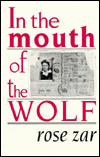 In the Mouth of the Wolf By Rose Zar |
Awards:
Caught in the Nazi trap in her native Poland, Rose Zar's father urged her to save herself by hiding "in the mouth of the wolf" -- within the enemy herself. She survived as a housekeeper for an SS commandant. A captivating tale for young adults. | ||||||||||||||||||||||||||||||||||
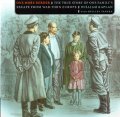 One More Border: The True Story of One Family's Escape from War-Torn Europe By William Kaplan |
The Holocaust is a complex topic that cannot be understood in a vacuum. Knowledge of how difficult it was to leave Europe in the late 1930's clarifies the Nazi entrapment of the Jews. This compelling picture book shows one middle class family who bartered every penny in exchange for the right to travel across Russia to Japan, and finally to Canada. The long journey begins in Lithuania when Father boldly flags down the car of a kind Japanese consul and obtains visas for him and the two children. But Mother is almost left behind because she is Russian-born and needs separate papers. Later, Mother is forced to give up the family's last sum of money along with her wedding ring to enter Japan. An especially disquieting moment comes when immigration officials force another Jewish family on the Trans-Siberian Express off the train. American-born students often have no frame of reference for the desperation of war refugees who must buy their way to freedom. This book will help them understand. Stephen Taylor's poignant illustrations are interspersed with archival photographs, maps, and historical sidebars. Teachers who cover the Holocaust should definitely include this book in their curriculum.
Working with Tanaka (On Board the Titanic), Kaplan delves into his father's childhood experiences for this combination family drama and history lesson. In 1939, Igor Kaplan and his younger sister, Nomi, leave their home in Memel, Lithuania, as their prescient parents keep one step ahead of the Nazis. In the Lithuanian capital, the now-legendary Japanese consul Chiune Sugihara gives Mr. Kaplan a visa for himself and the children. Mrs. Kaplan, who is Russian, needs separate exit and entrance visas; she somehow obtains the former just in time to join the family, already aboard the Trans-Siberian Express. After more dangerous journeys and 11th-hour deliverances, they finally reach Ontario, where the children's grandparents live. The Kaplans' saga, illustrated with attractive watercolors, is paralleled with archival photos and explanatory sidebars. For example, as the Kaplans flee Memel, photos on the facing page show Nazis goose-stepping and German soldiers marching through a burning Polish village; a three-paragraph caption defines WWII.
|
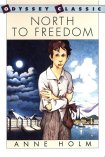 North to Freedom by Anne Holm
After escaping from an Eastern European concentration camp where he has
spent most of his life, a twelve-year-old boy struggles to cope with an entirely
strange world as he flees northward to freedom in Denmark.
|
|
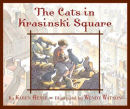 The Cats In Krasinski Square By Karen Hesse
The cats in Krasinski Square once belonged to someone.... And so did a young girl, whose family has been destroyed by war. As she and her sister struggle to survive amid the war's chaos, they became involved in a plan to help those still inside Warsaw's infamous Ghetto. Food must be delivered inside the Ghetto walls. But the soldiers have dogs that will sniff out the hidden food the smugglers bring to Warsaw by train. If the dogs can be distracted, then the smugglers might be able to slip away. Suddenly, a young girl and the cats in Krasinski Square are risking their lives to save those behind the Ghetto walls.
| Newbery Medalist Karen Hesse has written an achingly beautiful story about the courage of brave young women and men who, at great risk, fought not with weapons, but with their hearts and souls. Wendy Watson's luminous paintings inspire a visual journey to a time and place that must never be forgotten. A young Jewish girl and her sister, "passing" as Polish in WWII Warsaw, plot to sneak food, brought by collaborating train passengers, into the ghetto. Their scheme is jeopardized when the Gestapo meets the train with dogs that sniff out both smugglers and contraband food. To foil the Nazis, the sisters gather up the feral cats of Krasinski Square in baskets. They release the cats as a distraction to the dogs, thus allowing the food to be smuggled into the ghetto. Skilled pacing renders the cat solution a satisfyingly subversive surprise while Watson's illustration of the flummoxed Nazis underscores the ensuing chaos. The illustrations, with their soft but firm line and monochromatic sepia-toned palette, have an appropriate retro look. Among the great historical avalanche of Holocaust stories, Hesse has found a little-known vignette that she treats with her customary modest but elevating free-verse style, making a grave subject enormously accessible, gently humorous, and affectingly triumphant.
|
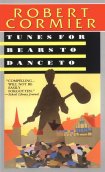 Tunes for Bears to Dance to By Robert Cormier
A masterful portrayal of hatred, prejudice and manipulation that challenges
readers to examine how they would behave in the face of evil. Henry meets
and befriends Mr. Levine, an elderly Holocaust survivor, who is carving a
replica of the village where he lived and which was destroyed in the war.
Henry's friendship with Mr. Levine is put to the test when his prejudiced
boss, Mr. Hairston, asks Henry to destroy Mr. Levine's village.
| Once again, Cormier explores a child's confrontation with the evil side of humanity. When Mr. Hairston, the racist grocer for whom Henry works, threatens to fire Henry and complicate his family's life if he does not destroy the miniature village a Jewish man has lovingly and painstakingly created, Henry wrestles with his decision. Geared toward a younger audience, the novel lacks the power typical of Cormier's work, and the characters are disappointingly one-dimensional, but the portrait of evil may inspire discussion. This brief, compelling book conveys the devastating effects of evil, whether its form is as huge and incomprehensible as the Holocaust, or as small and personal as another human being. Henry, a young teenager, is lucky to be employed. Since his brother's recent death, his father is paralyzed by depression; his mother works long hours to support the family. It's the early 1950s, and, with the return of the servicemen, housing and jobs are scarce. Unfortunately, Henry's boss is a bigoted, abusive individual whose hatred of others is so consuming that he intentionally sets out to corrupt the boy's goodness. He forces Henry to commit an ugly, violent act and betray a friendship with an elderly neighbor who has lost his home and family to the Nazis. As part of his rehabilitative therapy, Mr. Levine loving ly carves his vanished village and its population out of wood. The scenes in which he is "home" again demonstrate the Holocaust's horror in a deeply moving manner, and Cormier wrenchingly personalizes the man's grief. Tunes for Bears to Dance To, more a parable than a fully realized novel, is sharp, short, and to the point.
|
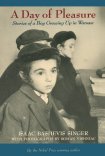 A Day of Pleasure : Stories of a Boy Growing Up in Warsaw by Isaac Bashevis Singer
Nobel Prize winner Isacc Bashevis Singer wrote both autobiographical and
fantasy tales for children which are deeply rooted in the lost cultural tradition
of his native Poland. This very special collection combines the stories he wrote
of his childhood with exuberant and timeless tales that can be included among
the world's great folk literature.
|
|
 Dangerous Dream By Felice Buckvar
Hella Weiss, a 13-year-old Holocaust survivor, is working at an
infirmary in a displaced-persons camp. Even though her father's
whereabouts are unknown, she still holds onto the dream that he
is alive. When she mentions the name Hans Wilhelm Weiss to a
friend, a man sitting nearby claims to be her long-lost father. He
wants to take her out of the camp, but she has vague doubts since
he is cold and unloving. However, she was very young when he
was arrested and doesn't remember him well. Through a series of
incidents, Hella discovers that this man is actually a Nazi for whom
her father worked in a concentration camp. The action is fast paced
and nonstop, complete with danger and gun play. The factual content
is accurate. This period of time and the DP camps after the war are
not often treated in books for this audience.
|
|
 Hide and Seek By Ida Vos
| Awards:
Rachel Hartog is only eight years old when the Nazis invade her native Holland. Gradually her childhood is disfigured: sent to a school for Jewish children only, forbidden to enter the parks or use the swimming pool, stripped of her beloved bicycle, forced to wear a yellow star, Rachel cannot understand the persecution of her family and friends. Drawing on her own experiences during WW II, Vos fills the narrative with understated but painfully realistic moments: for example, Rachel falls and scrapes her knee; a well-meaning stranger attempts to seat her on a public bench, forbidden to Jews; terrified and desperate, she bites his hand. The Hartogs then flee into hiding in a series of homes and are given false names, and Rachel and her younger sister are eventually separated from their parents. Although the feelings of the hidden and their protectors lack the complexity that characterizes Johanna Reiss's The Upstairs Room, Vos's novel deserves special attention for its sensitive and deeply affecting consideration of life after liberation.
|
 Dancing on the Bridge of Avignon By Ida Vos
| Awards:
For ten-year-old Rosa de Jong, dreams are her refuge from everyday life in Nazi-occupied Holland. Dreams and one other thing - her music, for Rosa is a talented violinist. Like other Jewish children, she can no longer go to school, but she still has her violin lessons with old Mr. Goldstein. Rosa's parents have a dream, too, one they hardly dare mention except in jokes about dancing in Avignon. But will their wartime dreams come true? Like Hide and Seek, this story is based on Vos' own wartime experiences and those of other Jews in the Netherlands during the dark days of the Nazi occupation. And like the first book, this story, translated from the Dutch, is told in a series of present-tense vignettes from the point of view of a child. Rosa, 10, dreams of the days before the war when she could still go to school, walk in the park, ride public transportation, take violin lessons, own a bike. Now she shakes when the doorbell rings: are the Nazis coming to take her and her family away? This isn't as taut as Hide and Seek; much of it reads like a docu-novel, with scenes and dialogue contrived to give us the facts. What's riveting is the ending. Rosa's family seems to be offered a miraculous chance to escape, only to be arrested and sent to the camps. Vos' epilogue explains that there were such rumors of deliverance at the time, all of them false. Holland in 1942 is not a safe place for Jews, yet the de Jong family does their best to live a normal life. "Normal" is a relative term, though, as 10-year-old Rosa is well aware. She loses classmates, teachers, and neighbors to concentration camps. She is teased and scorned by Nazi sympathizers. She helps make room for refugees, and suffers fear and uncertainty. Yet Rosa is still a "normal" child, surrounded by loving family and friends; she laughs, plays, pouts, gets into mischief, and experiences wonder, happiness, and hope. Her violin carries her through the story, and at book's end it saves her from certain death. This abrupt conclusion-which, despite an epilogue, leaves many questions unanswered-is Dancing on the Bridge of Avignon's only flaw. With most tales of Jews in World War II focused on hiding or concentration camps, its approach is unique. Vos's short, episodic chapters are well crafted; her writing is poignant in its understatement. Characterization is excellent-the best in Vos's books so far. This is a welcome addition to World War II novels and also gives a meaningful view of a family coping under immense stress.
|
 Anna Is Still Here By Ida Vos
Vos's autobiographical Hide
and Seek ranks among the best middle grade fiction about the Holocaust; this story,
a sequel of sorts, is even better. Anna, a Dutch Jewish girl, has survived the war in hiding.
She returns to school--a fifth-grader although she's 13--and is reunited with her parents,
who cannot yet bring themselves to tell her about their own ordeal (they spent years in a
forest, living below the ground). She knows a little about the concentration camps--enough
to be aware that her best friend has been murdered in one--and she struggles to
accommodate her knowledge, her sense of her parents' vulnerability, her own deeply
inculcated terrors and her eagerness to rejoin the world. Vos conveys Anna's
heartbreaking and heroic efforts with exemplary economy, and the anguish of Anna's
story is balanced by a subplot, however contrived, about another survivor being
reunited against all odds with her seven-year-old daughter. Vos looks beyond the
usual "happy'' ending of survivor stories, which typically conclude with liberation or
shortly thereafter, to pose more thoughtful questions about the price of survival; her
answers are hard-won and profoundly stirring.
|
|
 The Key Is Lost By Ida Vos
Like the classic
Hide
and Seek, this Holocaust survivor story is based on Vos' own experience
as a child in hiding during the Nazi occupation of Holland. The immediate, present-tense narrative tells it
from the child's bewildered viewpoint as she and her sister are separated from their parents and forced
from one secret hideout to another. They must change their names and deny who they are. Always they
depend on the kindness of strangers, who risk their own lives, even starve themselves, to save the
children. The ending is happy but still realistic: the children are reunited with their parents after the war,
yet the celebration is muted by the loss of all those relatives and friends who have not come back. This
is a good book to introduce the Holocaust to middle-grade readers, who will identify with the terror in
the home, but will not be ready to confront the violent details of the genocide. Connect this with escape
stories of the Underground Railroad.
|
|
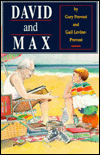 David and Max By Gary Provost
The underlying themes of this book are memory and the Holocaust. However, unlike
many recent books where the emphasis is on keeping the memory alive, this one has
as its key the fading memory of an old man. When David's grandfather, Max, thinks
that he has seen an old friend who was thought to have been killed during the war,
everyone except David thinks that the old man's mind is playing tricks on him. David is
convinced that Max is right, and he begins a quest to find Max' friend. He also, for the
first time in his life, begins to learn about the Holocaust, and about his grandfather's
experiences. This novel operates on many levels; the Holocaust is an obvious theme, but
the book also shows the close relationship between a young boy and his grandparents.
|
|
 Faraway Home By Marilyn Taylor
Based on true events, this is the story of Karl and Rosa, a brother and sister who escape from Nazi-occupied Vienna to Northern Ireland during World War II. Though they adapt themselves to a very different way of life there, the rationing, air-raid warnings, and spy scares constantly remind them that the threat of war is never far away. But with the help of Judy from Dublin and Peewee from Belfast, they learns that out of conflict and despair extraordinary friendships can grow.
| As 13-year-old Karl Muller watches the Anschluss parade from his family's Vienna apartment, he worries that his Jewish family will soon be facing terrible danger. Sure enough, as the months pass, Karl loses his gentile girlfriend, watches his uncle sink into despair, and sees the family business destroyed. His parents put him and his sister, Rosa, on a kindertransport that gets them to County Down, Ireland, where Karl is separated from Rosa and endures hard work and suspicion from the locals. He begins a tentative friendship with Judy, an Irish Jew, and with Peewee, an Irish-Catholic boy, and he's eventually reunited with Rosa. But war comes to Ireland, too, and Karl must decide how to help. The main characters are appealing, and the setting is intriguing in this well- researched novel by an Irish author. The real strength of the book, however, lies in its realistic portrayal of Karl's feelings and of the friendships he makes in his new surroundings.
|
 The Island on Bird Street By Uri Orlev
During World War II a Jewish boy is left on his own for months
in a ruined house in the Warsaw Ghetto, where he must learn all
the tricks of survival under constantly life-threatening conditions.
| "More than just a valuable addition to Holocaust literature . . . it should garner a wide audience, which is exactly what its spirited portrait of hope and dauntless courage deserves."
|
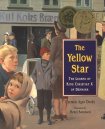 The Yellow Star: The Legend of King Christian X of Denmark By Carmen Agra Deedy
| Awards:
For centuries, the Star of David was a symbol of Jewish pride. But during World War II, Nazis used the star to segregate and terrorize the Jewish people. Except in Denmark. When Nazi soldiers occupied his country, King Christian X of Denmark committed himself to keeping all Danes safe from harm. The bravery of the Danes and their king during that dangerous time has inspired many legends. The most enduring is the legend of the yellow star, which symbolizes the loyalty and fearless spirit of the king and his people. The result is a powerful and dignified story of heroic justice, a story for all people and all times. Handsome double-page illustrations of Copenhagen and its residents during the Nazi-Occupation of World War II draw us into the events of a terrible time. We meet King Christian as he rides on horseback along the streets. We are with him in his office when he defies the Nazis order to fly their flag over his palace. When the edict comes that "All Jews must sew onto their clothing a yellow star," the king himself is reputed to have sewn a star on his own jacket. No one can actually corroborate this action by the King, yet it is known that no Jews within Denmark were forced to wear the yellow star, and more than 7,000 Danish Jews were smuggled to safety in Sweden during the war. The King's defiance was known throughout Europe and, factually true or legend, the story merits this straightforward retelling. Like Levine's Darkness over Denmark (reviewed on p.2023) this fiction picture book makes clear that the legend about the King of Denmark wearing a Jewish star never happened. Her focus is on the country's wise, beloved king and his support of the Jews. When the Nazis order the Jews to wear yellow stars, the king rides out on his horse wearing a star. Then the Danish people wear stars, "And once again, in the country of Denmark, there were only Danes." Sorensen's large, double-page paintings, close-up portraits and street scenes, express the strong individuality and the community of the Danish people and their bond with their leader. Henry Sorensen's pictures dramatize the confrontation between the Nazi commander and the king, as sepia scenes show the terror that is happening in Poland and elsewhere. In contrast are depictions of the warmth and strength of the Danish people going about their business. Deedy's author's note is an essential part of the book, as it distinguishes legend from fact and states the moral issue for discussion: "What if we could follow that example today against violators of human rights?" King Christian X of Denmark was a much beloved monarch who mixed easily among his countrymen. He knew he was trusted and respected by them and shunned bodyguards or any other royal barriers between himself and his people. Stories are told of his daily rides through the city of Copenhagen and of his stalwart resistance to Nazi oppression and criminality. The legend retold here, is one in which the King risks everything--his identity, his monarchy, and his very life in an attempt to stop the Nazis from tearing apart his country and harming his people. As a model of righteousness, as a clever strategist, and as a devoted leader, King Christian X sets the standard. He deserves a legendary place in history and this elegant picture book places him there, front and center among the heroes of our times. The spare text tells the simple story with splendor and bronze-tinged full-page paintings quietly underscore the heartbreak and the majesty of the man and this legend.
|
 The Last Mission By Harry Mazer
In 1944, as World War II is raging across Europe, fifteen-year-old Jack Raab
is a Jewish boy who dreams of being a hero. Leaving New York City, his family,
and his boyhood behind, Jack uses a false I.D. and lies his way into the U.S. Air Force.
| From their base in England, he and his crew fly twenty-four treacherous bombing missions over occupied Europe. The war is almost over and Hitler near defeat when they fly their last mission -- a mission destined for disaster. Shot down far behind enemy lines, Jack is taken prisoner and sent to a German POW camp, where his experiences are more terrifying than anything he'd ever imagined.
|
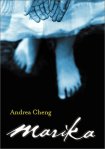 Marika By Andrea Cheng
Marika has a Jewish heritage but she’s a practicing Catholic. Although her father says religion is unimportant, he advises her not to act “so Jewish.” It’s not a good time to be Jewish in Budapest. Marika has heard bits and pieces about the war, and knows about bad things happening to Jews in other countries. But she’s convinced that those horrible acts cannot happen near her home. She’s more concerned about surviving her parents’ separation. By the time Marika is 11 years old, she has helped her father and uncle forge identity papers that will “prove” they are not a Jewish family. When Hungary is eventually occupied by the Nazis, Marika and her mother are taken away to a school where all Jewish people are gathered. Marika’s father bribes a man to buy her freedom but not her mother’s. Marika escapes, having forgotten to warn her mother not to volunteer for the work camps. The Jewish Holocaust in Budapest is characterized by its late and swift occurrence. Marika’s story reflects these tragic events.
|
|
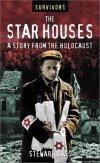 The Star Houses: A Story from the Holocaust By Stewart Ross
Bandi Guttmann is a fourteen-year-old Hungarian Jew living in Budapest in 1944. German forces have occupied the city, and life for Bandi and his family is about to become unbearable. Set apart from the rest of the community and denied basic rights, the Guttmann family's only weapon is their determination to survive. But in the face of mindless Nazi hatred, will their strength, love, and courage be enough to hold them together? Survivors is a brand-new and dramatic collection of short novels for young readers, each book about a young person caught up in a real-life conflict or disaster that boys and girls will recognize from their history books. The stories are fiction, but through each young hero's eyes, the boys and girls who read these tales will gain a deeper understanding of the day-to-day hardships and dangers encountered by people living and surviving through troubled times. Each book has a brief introduction relating actual historical events, and at the end of each book, young readers will find a brief historical note that places the story in a larger context plus a glossary of terms specific to the time and place. Boys and girls will also find a list of suggested further reading. Line illustrations capture the atmosphere of each story.
|
|
 My Canary Yellow Star By Eva Wiseman
The Second World War was a time of terrible injustices. It was also a time of incredible bravery. My Canary Yellow Star is the remarkable story of one of the last century’s greatest heroes, Raoul Wallenberg, who was responsible for saving as many as 100,000 lives.
| Young Marta’s life in Budapest has been shattered by the war. First, her school closes. Jews are prohibited from attending classes. Then her father, along with other able-bodied men, is arrested and sent to work digging ditches on the eastern front. The family’s apartment is confiscated, and Marta, her brother, and her mother must share cramped space with her aunt and cousin. Food, warm clothing, and any kind of personal freedom have all but vanished. Jewish life becomes more and more confined as the old people, women, and children are forced into the ghetto. From there, the next step is the waiting cattle cars and the concentration camps. But Marta’s family is lucky. They are numbered among those who could be saved by the efforts of Raoul Wallenberg. Among the few points of hope was this extraordinary Swedish diplomat. Raoul Wallenberg issued papers to thousands of Jews, declaring them to be Swedish citizens. Wallenberg was questioned by the Russians after the war and disappeared, possibly to die in Siberia. An international movement has been in place for decades to press Russia for news of his fate. Although details of his death remain a mystery, he has come to represent courage and justice in the face of great evil. |